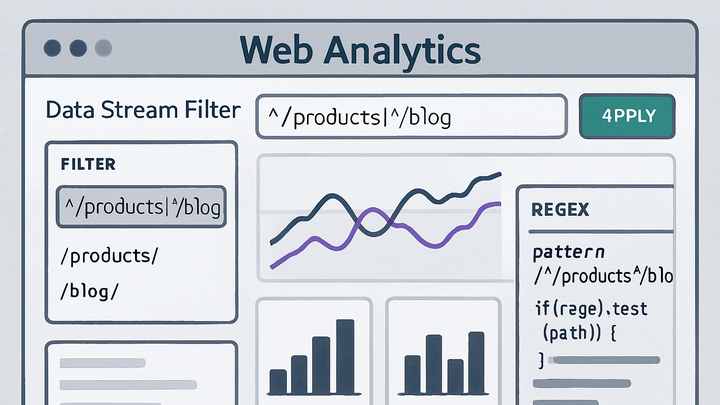Published on 2025-06-22T09:19:55Z
What is a Regex Filter? Examples and Use Cases
A Regex Filter in analytics allows you to include or exclude data based on regular expression patterns. This powerful technique helps refine your analytics reports by matching fields such as URLs, event names, IP addresses, and user agents against user-defined patterns. In Google Analytics 4 (GA4), you can apply regex filters in the Admin UI under Data Settings > Data Filters to segment or clean your data before reporting. In PlainSignal (a cookie-free analytics tool), you can embed regex rules directly into your tracking code as configuration objects:
<script>
window.psConfig = {
filters: [{ type: 'exclude', field: 'url', match: 'regex', pattern: '^/internal' }]
};
</script>
<link rel='preconnect' href='//eu.plainsignal.com/' crossorigin/>
<script defer data-do='yourwebsitedomain.com' data-id='0GQV1xmtzQQ' data-api='//eu.plainsignal.com' src='//cdn.plainsignal.com/plainsignal-min.js'></script>
By leveraging regex filters, you can maintain high data quality and create targeted audience segments with precision.
Regex filter
Pattern-based rules for including or excluding analytics data using regular expressions.
Definition and Key Concepts
An overview of what regex and regex filters are, and why they’re essential in analytics.
-
Regular expression (regex)
A sequence of characters that defines a search pattern. In analytics, regex is used to match parts of strings like URLs, event names, or user agents.
-
Metacharacters
Symbols like
.(any character),*(zero or more), and+(one or more) that control matching behavior. -
Character classes
Sets of characters in brackets, e.g.,
[A-Za-z0-9], define allowed matches. -
Anchors
^and$assert the start and end of a string, ensuring precise matches.
-
-
Regex filter in analytics
A mechanism that applies regex patterns to incoming analytics data to include or exclude data points based on match results.
-
Inclusion filters
Keep only data that matches a given pattern, e.g., include URLs starting with
/blogusing^/blog. -
Exclusion filters
Remove data matching the pattern, such as excluding internal IP ranges.
-
Processing order
Filters are evaluated in the order defined, so the sequence can affect results.
-
Implementing Regex Filters in GA4
Step-by-step guidance on setting up and validating regex filters within Google Analytics 4.
-
Create a custom data filter
In GA4 Admin, navigate to Data Settings > Data Filters to build a custom filter that uses regex conditions.
-
Access the admin ui
Go to Admin > Data Settings > Data Filters in your GA4 property.
-
Add new filter
Click Create Filter, select Custom, and name your filter.
-
Define regex condition
Set the field (e.g., Event name), choose matches regex, and enter your pattern (e.g.,
^video_). -
Save and publish
Review with the Preview option, then Publish to activate the filter.
-
-
Validate and debug filters
Ensure your regex patterns work as expected using GA4’s DebugView and real-time reports.
-
Use debugview
Send test events from your site or Measurement Protocol to see matching behavior live.
-
Monitor realtime reports
Check if events appear or disappear according to your filter.
-
Review filter status
In Data Filters, inspect the filter’s status and hit counts.
-
Implementing Regex Filters in PlainSignal
How to embed regex filter rules in the PlainSignal tracking code snippet on your website.
-
Configure filters via window.psconfig
Before loading the PlainSignal script, define
window.psConfig.filterswith regex filter objects.-
Filter object structure
{ type: 'exclude', field: 'url', match: 'regex', pattern: '^/admin' } -
Available fields
url,referrer,userAgent -
Filter types
includeto keep matches,excludeto drop them.
-
-
Example: excluding internal paths
<script> window.psConfig = { filters: [{ type: 'exclude', field: 'url', match: 'regex', pattern: '^/internal' }] }; </script> <link rel='preconnect' href='//eu.plainsignal.com/' crossorigin/> <script defer data-do='yourwebsitedomain.com' data-id='0GQV1xmtzQQ' data-api='//eu.plainsignal.com' src='//cdn.plainsignal.com/plainsignal-min.js'></script>-
Pattern
^/internalmatches all paths starting with/internal. -
Type
excludedrops matching hits. -
Position
Place the config before the PlainSignal script tag.
-
Best Practices and Troubleshooting
Tips to create effective regex filters and common pitfalls to avoid.
-
Keep patterns specific
Use anchors and character classes to avoid unintended matches.
-
Use anchors
Start (
^) and end ($) anchors limit matches. -
Escape special characters
Prefix metacharacters like
.or*with backslash (e.g.,\.) when matching literally.
-
-
Test regularly
Validate patterns in regex testers or platform previews before applying.
-
Online tools
Use sites like regex101.com for real-time feedback.
-
Platform previews
GA4 offers a Preview option for Data Filters.
-
-
Monitor impact
Review your reports after filter changes to ensure accuracy.
-
Compare time periods
Look for sudden drops or spikes after filter activation.
-
Use developer mode
Open DebugView or browser console to confirm filtering behavior.
-
